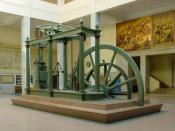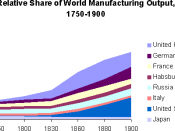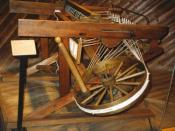Industrialization of Europe
The Industrial Revolution refers to the greatly increased output of machine-made goods that began in England during the 18th century. Before the Industrial Revolution, people wove textile by hand. Beginning in the middle 1700s, machines did this and other jobs as well. The Industrial Revolution started in England and soon spread to Continental Europe and North America.
Beginning in the early 1700s, large landowners dramatically improved farming methods. These agricultural changes amounted to an agricultural revolution. They eventually paved the way for the Industrial Revolution. After buying up the land of village farmers, wealthy landowners enclosed their land with fences or hedges. The increase in their landholding enabled them to cultivate fields, using new seeding and harvesting methods. Within these larger fields, called enclosures, landowner experimented to discover more productive farming methods to boost crop yields. The enclosure movement had two important results. First, landowners experimented with new agricultural methods.
Second, large landowners forced small farmers to become tenant farmers or to give up farming and move to cities. The seed drill was invented in 1701 and it allowed farmers to sow seeds in well-spaced rows at specific depths. A larger share of the seed germinated, boosting crop yield.
The process of crop rotation proved to be one of the best developments of the scientific farmers. The process improved upon older methods of crop rotation, such as, the medieval three-field system. One year, for example, a farmer might plant a field with wheat, which exhausted soil nutrients. The next year he planted a root crop, such as turnips, to restore nutrients. This might be followed in turn by barley, the clover. These improvements in farming that began in the early 1700s made up an agricultural revolution. As food supplies increased and living conditions improved, England's population mushroomed. An increasing population boosted the demand for food and goods. As farmers lost their land to large enclosed farms, many became factory workers.
The Industrial Revolution begins in England because in addition to large population of workers, the small island country had extensive resources. And Industrial Revolution--the process of developing machine production of goods--required such resources. These natural resources included 1) water power and coal to fuel the new machines; 2) iron ore to construct machines, tools, and buildings; 3) rivers for inland transportation; 4) harbors from which its merchant ships set sail.
Industrialization widened the gap between industrialization and non-industrialization countries, even while it strengthened their economic ties. The impact of Industrialization of Europe called for industrialized countries to get more raw materials. This cause these nations to look for colonies thus the beginning of another age, The Age of Imperialism. The impact on the industrialization of Europe had on the people Asia, Africa, and the Middle East is that these regions became the colonies to the industrialized nations. Not only did these countries provided with the appropriate raw materials but also the cheep labor for running the factories of the industrialized nations.


